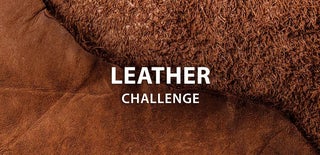Introduction: Scrap Leather Scales
My daughter bought me a giant bag of leather scraps recently and wasn't sure what I would do with them initially. They were all pretty small and very wrinkled. Eventually, I thought I would try to create a scale pattern for some bicycle panniers. The scales themselves have quite a few steps, so I'll save the bag process for later. For now, here's how I created leather scales with scraps.
Supplies
scrap leather
laser cutter
waxed thread
towels
1/8" plywood
Barge contact cement
rolling pin
white, tacky, or wood glue
parchment paper
tape
Step 1: Prep Scraps
All the scraps were crammed into a bag and were very wrinkled. To flatten them out, I soaked them in warm water for a few minutes and then laid them out on towels. I used a rolling pin to smooth out the wrinkles then allowed them time to dry. The larger strips were convenient to hand out to dry in the sun.
Step 2: Cut Scales
I used my laser cutter to cut as many scales as I could from each piece of leather. The cut file is attached to this step.
After the pieces were cut, I stacked them up to keep track of how many I still needed to make the bags I had planned.
Attachments
Step 3: Wash Scales
Once I had more than enough pieces, I washed them in the washing machine with a small amount of soap in cold water. The laser leaves a fair amount of soot around the edges that are not easily removed by hand washing.
Once again, lay each piece flat to dry.
Step 4: Glue Scales
Cut the various guides from 1/8" plywood. The cut file is in step 2.
Glue them together with tacky, white, or wood glue.
Lineup the first row of scales on a strip of tape.
Use the guides to apply Barge contact cement to the appropriate areas on the scales. Wait a few minutes for the glue to set, then use other guides to place each scale and press it firmly in place. I made two sets of guides, so use whichever ones you prefer.
Step 5: Stitching
Once you've glued your scales together, they need to be stitched. While the Barge contact cement is great, I found that it didn't adhere great to the shinier fronts of certain leathers. It held well enough to stay together while I stitched it.
Punch four holes at each intersecting set of scales as shown. I created my own tool for punching these stitching holes. You can find an ible for that here.
Step 6: Stitch and Create
In each set of four holes, start with the vertical stitch, then do the horizontal stitch. Repeat on all scales and then you can use them for any project you can imagine. I'm still working on stitching enough of these for two pannier bags for my bicycle and will share that project and pattern when it's completed.

Runner Up in the
Leather Challenge














